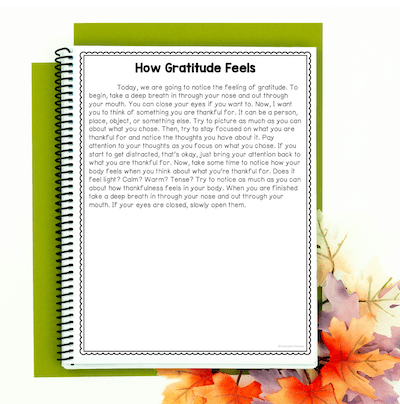How School Counselors Can Encourage An Attitude Of Gratitude
Have you ever just sat back and reflected on all of the things that you’re thankful for? When I’ve taken the time to do this (which, admittedly isn’t often enough), I feel a change in my attitude, my perspective, and even my whole day. Gratitude is powerful, and it’s not just for grown ups.
In our schools, it’s common for teachers to focus on the theme of gratitude during November. But, what if there are things that we can do to encourage an attitude of gratitude year round? Helping students learn to enjoy the small things and to be thankful for the things in their life, isn’t just beneficial during one month of the year.
These tips and activities will help your students incorporate the practice of gratitude into their lives year round!
This post contains affiliate links. Please review my full disclosure policy for additional information.
1- Be Thankful
Kids are always watching. They are always learning by what we do, and don’t do. If they notice that you are practicing gratefulness, even when it’s hard, they will see that it’s something that you actually value enough to implement in your own life. On the other hand, if you continue to teach about gratitude, but don’t actually practice it yourself, kids will get the message that it’s not that important.
Some ways to incorporate gratitude into your life are:
For each thing you complain about, share 3 things you are thankful for
Find a gratitude app to use, such as Presently: A Gratitude Journal or 365 Gratitude
Make a habit out of telling friends and family that you are thankful for them, and why
2- Make Gratitude a routine
Grab these FREE gratitude mindfulness scripts here!
If you want to get better at something, or to do it more often, create a space for it in your routine. Creating a practice of gratitude - for yourself and your students - is no different.
A school counselors’ day is crazy, and it can be so hard to remember the things that aren’t right in front of us. Making time for gratitude practices in your schedule will not only help with it becoming a rhythm in the lives of you and your students, but it will also make it harder to forget. When we incorporate gratitude into our daily routines, we are showing students that it’s something that really matters.
Some ways to incorporate gratitude into your counseling rhythms include:
Starting your small groups by having everyone share one thing they are thankful for
Leading students through mindfulness scripts that promote gratitude
Telling 3 students a day that you are thankful for them, or for something they have done
3- Explicitly Teach About Gratitude
While modeling thankfulness and incorporating it into the things that you are already doing is great, we can’t forget to talk to students explicitly about gratitude. Teaching lessons about gratitude will help kids learn more about what gratitude is, why it matters and how they can practice it. Doing intentional lessons about this topic also gives the students a chance to ask questions, and to clear up any misconceptions they may have.
Here are some easy lesson ideas:
Decorate notebooks and turn them into gratitude journals. Kids can write each day about the things they are thankful for, from that day
For fall-themed gratitude lessons, grab these no prep activities
Use books like Thankful by Eileen Spinelli or Gratitude Is My Super Power by Alicia Ortego
4- Incorporate Gratitude Into Your Decor
I’m all about having a cute and welcoming office - but it’s even better when it serves a purpose! Incorporating a theme of gratitude into your decor can be a great way to keep thankfulness in the front of both your and your students’ minds.
Here are a few office decor ideas that promote gratitude:
A Thankfulness Jar
Keep a mason jar or another type of container in your office with colored post- it notes or small pieces of paper next to it. Write down things that you are thankful for, put them in the jar, and invite students to do the same. After the jar is full, you can even take the papers out and staple them together to form a little book to keep on display in your office!
A Paper Chain
Who doesn’t love a good paper chain? To do this, just take strips of paper (construction paper, craft paper, Astrobrights, etc.) and have students write what they are thankful for on them. Then, bend the strips into connected circles and hang the chain across the ceiling of your office or around a bulletin board, etc. You can do this activity during a singular lesson or small group, or you can have students add to it over time.
Gratitude isn’t just something that’s helpful once a year. These practices will help you and your students cultivate a practice of gratitude that you can use year round.





